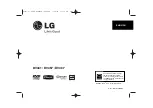
3
For Broadcasters
Over 7,000 HDCAM-SR VTR units are in use worldwide.
Key factors in this widespread adoption are visually
lossless compression (4:2:2) and 12-channel audio
recording. Also, despite extremely high bit-rate
HDCAM-SR recording, these decks are exceptionally
robust, and as equally ruggedized as other 1/2-inch
VTRs from Sony such as the proven BETACAM™ and
Digital BETACAM™ Series. In fact, a host of stations
now go on-air directly from the HDCAM-SR deck. In
nonlinear-based environments, the HDCAM-SR deck
plays a vital role, enabling double-speed material
transfer via a dual-link HD-SDI interface or a 3G-SDI
interface, as well as transfer of materials in industry-
standard MXF via the Gigabit Ethernet interface. The
HDCAM-SR VTR combines historically-reliable tape
media and file-based material handling on an open-
standard format, making it ideal for bridging base-band
and file-based environments.
Future Productions
Right now, 3D is the hottest trend in the production
market. HDCAM-SR VTRs enable Dual Stream recording
on a single tape, and even realize this feature in high-
quality 4:4:4 recording*
1
. As third-party NLE support for
Dual Stream mode expands, 3D production with the
HDCAM-SR VTR is heading for new heights now and in
the future.
Looking ahead, Sony has for many years held the vision
of providing a total 1080 50p/60p production tool set,
comprising everything from camera and switcher to VTR
and display. With the latest remarkable developments
in consumer display technology, the general public
can now watch 1080 50p/60p progressive imagery in
the living room. Due to limitations in aerial transmission
bandwidth, it’s likely that 1080-interlaced and
720-progressive transmission standards will co-exist in
the foreseeable future. With this in mind, Sony is giving
on-going support to 1080 50p/60p-based production as
the ideal production solution for premium content such
as sports, concerts, and documentaries.
SRW-5000
SRW-5500
SRW-5100
For ODS (Other Digital Stuff: alternative content
to feature movies) - and in particular the recently
discussed large-venue screening issues, including digital
cinema - HDCAM-SR products offer key capabilities such
as extreme image quality and 12-channel audio.
Last but not least, 4K/2K digital projection has been
making in-roads into premium theaters. In the future,
4K/2K content production is likely to grow very rapidly.
However, right now, 4K/2K Digital Intermediate (DI) is
an engineering challenge for postproduction facilities
that are struggling to secure processing power, network
bandwidth, and storage space. HDCAM-SR VTRs
provide the solution with outstanding capabilities such
as 4K/2K uncompressed data recording onto tape,
and the conversion of 4K/2K image file recording to
HD video recording. Furthermore, as to 2K contents, it
is possible to play back and record in real time. These
capabilities serve to significantly lower the barriers to
handling 4K/2K image files.
In conclusion, future cinema and TV production needs
will be well served by choosing the HDCAM-SR VTR.
*1: Requires a future upgrade planned to be available in the first half of 2011.
Choice for Today and Tomorrow




































